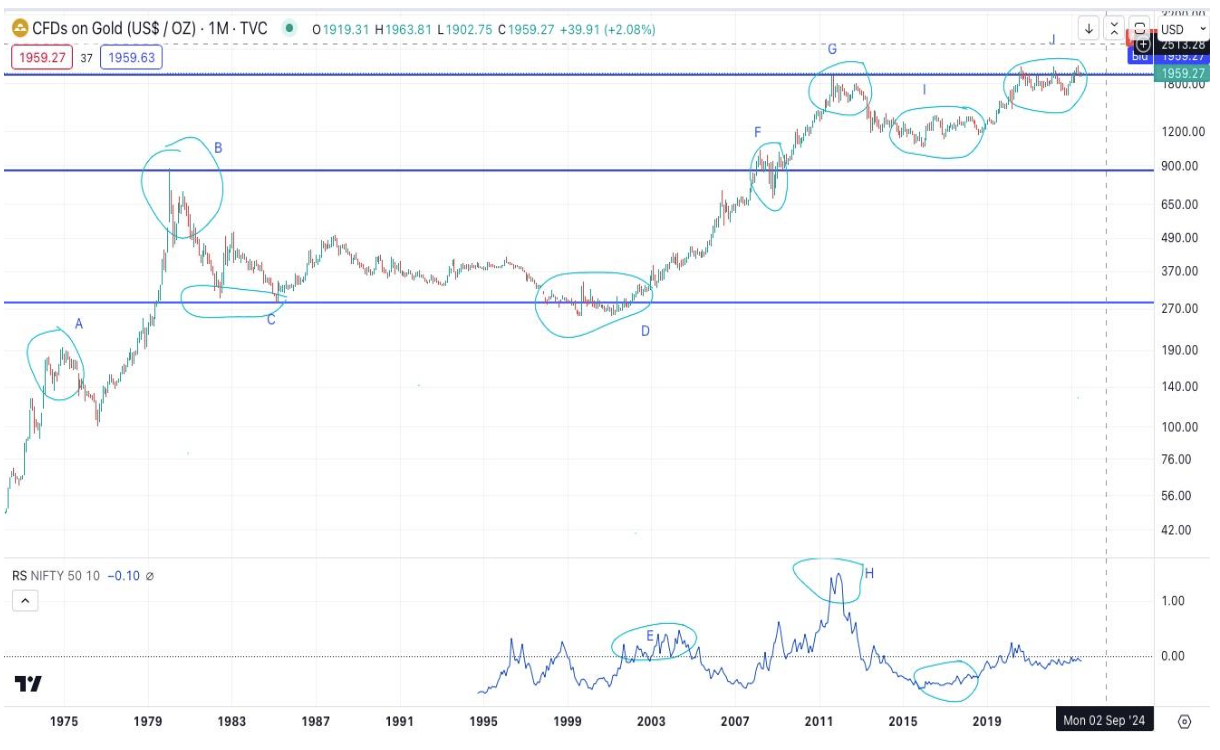


Source: iStock
Historical Price Movement of Gold (And what can be expected in the not too distant future)

Chart Scrip: Gold price in US $/oz.
Chart Period: 1st March 1972 till date. (Just after President Nixon removed the US from the Gold standard in 1971).
RS Nifty (bottom- portion of the graph to study relative strength of Gold price vs Nifty. Starts from 1994 which is inception date of Nifty).
“History doesn't repeat itself but it often rhymes”- Mark Twain
There is no statistical correlation between the price of stocks and gold. However, there are certain observable macro trends which we will highlight in this article.
Note: In the early 70’s Gold was close to $40/oz (prices on right). Since April 20 to date it has been oscillating between $1600/oz to $2081/oz.

Point A in the graph above corresponds to the price jump of gold in the aftermath of the 1973-74 Oil Crisis. The resulting instability (gold seems to ‘sometimes’ do well when there are periods of economic uncertainty) pushed the price of gold well above $100 for the first time.

Point B in the graph above corresponds to the period of stagflation in the US and developed economies. This pushed the price of gold much above the range of Point A and to a high of $ 875 in Jan 1980.

Point C in the graph correspond to a point where gold prices settled into a relative low and where the monetary policies of Paul Volcker (erstwhile Federal Reserve chairman pushed the fed funds rate to 20%) where being pursued. This is the period from around 1981-1985. Gold prices settled at close to $300 at the lower end in this period.

Point D is a consolidation of the prices at around the $300 range. This is the period between 1997 up to about 2003. This period corresponds with the boom and bust of the Dot Com bubble. Though the economy was in turmoil, the price of gold remained subdued.

Point E (in the Nifty RS portion of the graph) indicates that gold prices had slowly started doing better than the index. The price of gold begins to move up but there is relative underperformance with the index (Nifty RS line drops below 0).

Point F corresponds with the Global Financial Crisis of 08-09 (GFC). Prices consolidated sideways around their previous highs of 1980 for a short while before beginning another leg up reaching a high of $1920/0z in September 2011 (we are retesting these levels only now).

Point H indicates the point where there was a frenzy for gold (in the aftermath of the GFC and the rapid increase in the price of gold).

Point I corresponds to the period between June 2014- September 2018. Gold prices were generally depressed and there was underperformance with respect to the Nifty.

Point J is the current period beginning at about April 2020.
The current movement in the price of gold resembles the move from Point D in the graph (i.e. the period from 1997-2003) where though the prices were stagnant there was relative strength in the prices vis-à-vis the Nifty. Gold is showing decent relative strength in the recent period.
Technical Analysis theory suggests that if the price of gold breaks through its long term resistance of $2100 strongly, then it should be in an up move. However, while we do expect gold to do well in the short term, it might not do as well as the equity markets (which can be tracked by the RS line). The point where gold starts showing better relative strength than the market might portend the end of the bull rally in equities.
Disclaimer: The data/information compilation in this article is the Author’s comment on general trends in the securities market and discussions of broad-based indices. The information/data provided here is not a research report as defined under the Securities and Exchange Board of India (Research Analysts) Regulations, 2014 (SEBI RA Regulation, 2014). Thus, the Author is not required to have registration as a Research Analyst under the SEBI RA Regulation, 2014.
The information/data provided in this article is from publicly available data, and appropriate references have been given, which we believe are reliable. While reasonable endeavours have been made to present reliable data related to current and historical information, the Author does not guarantee the accuracy or completeness of the data/ information in this article. Accordingly, the Author or any of his connected persons, including his associates or employees, shall not be in any way responsible for any loss or damage that may arise to any person from any inadvertent error in the information/data contained, views and opinions expressed in this article.
The information/data provided in the article is purely for information purposes and to disseminate knowledge on the general trends in the securities market. The same does not constitute investment recommendation/advice or an offer or solicitation of an offer to buy/sell any securities.
No person should rely solely on the information/data in this article and must make investment decisions based on their own investment objectives, judgment, risk profile and financial position. The recipients of the article may take necessary professional advice before acting on it.
Investment in securities market are subject to market risks. Read all the related documents carefully before investing.

Source: iStock